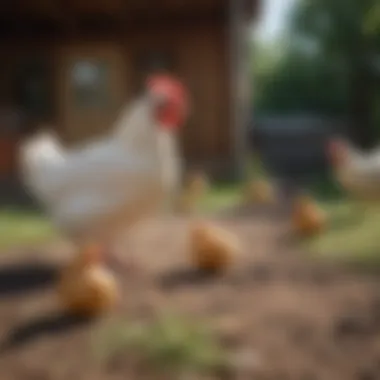Top Chicken Breeds for Maximum Egg Production


Intro
When considering the best chickens for egg production, it is essential to look at various factors such as breed characteristics, egg yield, and suitability for different rearing environments. This guide aims to provide an in-depth understanding of the top breeds of chickens that excel in egg production. By exploring their temperaments, health needs, and care requirements, potential poultry owners can make informed choices to maximize their egg yield. The focus will also be on how these chickens fit into their environments and their contributions to sustainable farming.
Animal Profile
General Overview
Chickens are domesticated birds that have been bred for centuries, primarily for their meat and eggs. Different breeds exhibit unique traits when it comes to egg production. Some chickens are prolific layers, producing a large quantity of eggs throughout the year, while others may produce fewer but larger or higher-quality eggs. Understanding these traits is crucial for those looking to keep chickens chiefly for their eggs.
Habitat and Distribution
Chickens are adaptable animals, capable of thriving in various habitats. Typically, they are raised in backyards, farms, or both. The environment can significantly influence their egg-laying abilities. Chickens require a comfortable living space, secure from predators, and with enough room for them to move around. Access to both indoor and outdoor environments contributes to their overall health and productivity.
Fascinating Facts
Unique Traits and Adaptations
Chickens have unique adaptations that help them in egg production. Some breeds possess a more efficient food conversion ratio, which translates into better egg-laying capabilities. Barred Rocks, for instance, are known not just for their delightful appearance but also for their reliable egg production.
Historical and Cultural Significance
The significance of chickens in various cultures cannot be overstated. In many regions, they have played an important role in agriculture and cuisine. For example, in Chinese culture, hens symbolize fertility and prosperity. This historical connection highlights the enduring and multifaceted relationship humans have with these birds.
Conservation Status
Current Population Trends
While chickens are generally not considered endangered, certain specific breeds face population declines. Conservation efforts are now focusing on preserving these breeds to maintain genetic diversity. This is critical not only for biodiversity but also for future agricultural resilience.
Threats and Challenges
The primary threats to chicken breeds include habitat loss and the rise of industrial farming practices, which often prioritize quantity over diversity. Ensuring proper care and sustainable practices can help mitigate these threats. It is important for poultry enthusiasts to take part in preservation initiatives.
Care Tips for Pet Owners
Basic Needs and Requirements
To raise healthy and productive chickens, owners must meet several basic needs. Chickens require a balanced diet rich in minerals and protein to support egg production. Also, it is essential to provide adequate shelter, fresh water, and safe outdoor space for free ranging.
Health and Wellness Tips
Regular health checks and vaccinations can help maintain a healthy flock. Keep an eye out for signs of illness, such as changes in egg production or behavior. Providing a stress-free environment will also contribute to their overall well-being.
“The right care can significantly enhance both the quality and quantity of eggs produced by your chickens.”
Prologue to Egg-Laying Chickens
Egg-laying chickens are a vital aspect of poultry farming. Understanding their characteristics, needs, and the best breeds for egg production helps optimize output. Farmers, hobbyists, and educators often seek clarity on these topics to ensure proper care and maximize the benefits obtained from these animals. This section will provide a foundation for those looking to delve deeper into the specifics of egg-laying chicken breeds.
Understanding Egg Production
Egg production is a complex process influenced by various factors. The hormonal cycles, breed characteristics, and environmental conditions play vital roles in how many eggs a chicken will lay. Typically, chickens reach peak production at about six months of age, depending on the breed. Some breeds consistently lay eggs almost daily, while others may produce less frequently.
Factors that influence egg production include:
- Breed Type: Certain breeds are more prolific layers than others.
- Diet: A balanced diet rich in protein and calcium is essential for optimal production.
- Lighting Conditions: Chickens require ample light exposure to stimulate egg production cycles.
- Age: Younger chickens tend to lay more eggs than older ones.


Ensuring that these elements are addressed is crucial for anyone looking to raise chickens for egg production. Proper understanding can lead to more effective management practices that enhance both the health of the chickens and the quantity of eggs produced.
Importance of Breed Selection
Selecting the right breed of chicken is paramount for successful egg production. Different breeds come with varying traits, including egg output, egg quality, and temperament. Choosing the best breed requires consideration of the specific environment and personal goals. For instance, if a farmer wants high egg yield, breeds such as Leghorns or Rhode Island Reds may be preferable.
Some key points to consider when selecting a breed include:
- Egg Production Rate: Some breeds have a higher output and frequent laying patterns.
- Egg Quality: The size, shell strength, and yolk color can differ significantly among breeds.
- Temperament: Consideration of chicken behavior can influence management and care routines.
In summary, breed selection not only impacts productivity but also determines the overall experience of raising chickens for egg production. It is an essential step that forms the bedrock of successful poultry farming.
Key Characteristics of Egg-Laying Breeds
Understanding the key characteristics of egg-laying breeds is essential for anyone keen on poultry farming. Focusing on these elements can lead to better decision-making regarding which chickens to rear for optimal egg production. This section delves into specific factors such as egg production rate, egg quality, and the temperament and behavior of breeds. These characteristics greatly influence not only the egg yield but also the overall experience of keeping chickens, especially for new poultry enthusiasts.
Egg Production Rate
The egg production rate is one of the most significant factors to consider when selecting chicken breeds for egg laying. This measure indicates how many eggs a hen can produce over a given period, usually calculated as an output per year. High-producing breeds, like the Leghorn, are known to lay above 300 eggs annually, making them ideal for farms prioritizing profitability.
- Factors influencing production rate: Various elements affect a chicken's output, including breed, age, nutrition, and environmental conditions. Younger birds typically produce more eggs and gradually slow down as they age. Proper nutrition focusing on balanced feed is also key to ensuring hens maintain their production rates in peak performance.
- Production during different seasons: Some breeds show different laying patterns throughout the year. Understanding these cycles can help farmers anticipate egg availability and manage their operations more effectively.
In summary, choosing a breed with a high egg production rate can have a direct impact on the viability of a poultry venture.
Egg Quality
Egg quality encompasses several factors such as shell strength, yolk color, and freshness. These attributes not only affect marketability but also influence consumer preferences. For instance, brown eggs may be perceived as more nutritious in certain markets, despite no significant nutritional difference between brown and white eggs.
- Shell quality: Strong, sturdy shells are essential for preserving the contents inside. Breeds like the Australorp often produce eggs with good shell quality, which is valuable for both producers and consumers.
- Yolk color: The color of the yolk varies depending on the hen's diet. A diet rich in greens and carotenoids can enhance yolk pigmentation, often making the eggs more appealing to buyers.
- Freshness and storage: Fresh eggs will have high albumen stability and a more rounded shape. Understanding how to maintain egg freshness post-laying is crucial for maximizing quality.
Ultimately, prioritizing breeds that deliver high-quality eggs can lead to better customer satisfaction and potentially higher prices in the market.
Temperament and Behavior
Temperament is often overlooked but can be a critical characteristic when selecting egg-laying breeds. A good temperament promotes easier management and enhances the overall experience of keeping chickens. Breeds with calm and friendly dispositions are typically easier to handle, reducing stress for both the birds and their owners.
- Social behavior: Chickens are social animals, and breeds like Rhode Island Reds often exhibit friendly characteristics. This trait promotes a harmonious environment that can lead to more stable egg production.
- Aggression levels: Some breeds may show more aggression than others. Understanding which breeds tend to be more docile will facilitate a smoother cohabitation in flocks.
- Adaptability to surroundings: A breed’s ability to adapt also affects temperament. Egg layers that can thrive in varied environments will likely be less prone to stress and illness.
Overall, selecting breeds with desirable behavior traits can lead to healthier flocks and a more successful poultry operation.
In choosing egg-laying breeds, it is vital to consider egg production rate, egg quality, and temperament. These characteristics significantly determine the success and enjoyment of raising chickens.
Top Chicken Breeds for Egg Production
Selecting the right chicken breed is crucial for maximizing egg production. Each breed has unique characteristics that affect productivity, egg quality, and overall ease of care. This section outlines some of the most effective chicken breeds for egg-laying, providing insight into their individual strengths and considerations. Understanding these specifics can help poultry enthusiasts make informed decisions that meet their needs.
Leghorn Chickens
Leghorn chickens are renowned for their high egg production rates. They can lay up to 300 eggs per year. Leghorns are typically white with a slim build, which makes them efficient foragers. Their active nature allows them to adapt well to various environments, but they tend to have a more skittish temperament than other breeds.
In terms of egg quality, Leghorns produce large white eggs. Their hardiness makes them suitable for both backyard flocks and commercial operations. However, their need for space for exercise should not be overlooked. If they do not have adequate room to roam, production may decline.
Rhode Island Reds
Rhode Island Reds are a favorite among backyard farmers due to their hardiness and egg consistency. They can lay approximately 250 to 300 brown eggs annually. Their ability to adapt to different climates makes them a versatile choice. Additionally, they exhibit a calm demeanor, making them easy to manage.
The eggs from Rhode Island Reds are known for being large and nutritious. This breed is particularly recommended for those who prioritize both quality and quantity in egg production. The dual-purpose nature of Rhode Island Reds, serving both as an egg layer and meat source, is an added bonus for mixed farming operations.
Plymouth Rocks


Plymouth Rocks are recognized for their friendly disposition, which makes them suitable for family farms. They lay around 200 to 250 medium-sized brown eggs each year. Their attractive feather pattern and moderate size make them visually appealing as well.
In terms of care, Plymouth Rocks are known for being relatively low-maintenance. They thrive in free-range environments and have a good foraging instinct. Their calm behavior contributes to a harmonious flock environment. This breed is perfect for those looking to blend aesthetic enjoyment in poultry keeping with effective egg production.
Australorps
Australorps are an exceptional breed from Australia. They have a remarkable egg-laying capability, averaging around 250 eggs per year. Their glossy black feathers and larger size distinguish them among other layers. Australorps are not just efficient egg producers, but they are also praised for their friendly nature.
These birds lay large brown eggs that are favored for their flavor and quality. With good adaptability to various climates, Australorps can perform well in both hot and cold conditions. Their docile temperament makes them a preferred choice for novice poultry keepers.
Orpingtons
Orpingtons are large, friendly birds also known for their excellent egg production. They typically lay 175 to 230 large brown eggs annually. Their friendly and docile nature makes them suitable for backyard settings, often becoming pets as well as egg producers.
Orpingtons are particularly suited for colder climates due to their thick plumage. They tend to be calm and are relatively easy to handle. The blend of meat and egg production makes Orpingtons a versatile breed for various farming systems. Their reputation for consistent quality also makes them a reliable choice for those focusing on egg output.
In summary, selecting appropriate chicken breeds can significantly influence overall egg production. Each breed—whether it's Leghorn, Rhode Island Red, Plymouth Rock, Australorp, or Orpington—offers distinct traits that can cater to different needs and environments. The key is to understand these differences to align with your goals.
Emerging Breeds of Egg-Layers
The exploration of emerging breeds of egg-laying chickens is vital for understanding the evolving landscape of poultry husbandry. These breeds offer new alternatives not just in egg production, but also in adaptability and health. As traditional breeds dominate the market, the emergence of lesser-known varieties presents opportunities for poultry enthusiasts and farmers interested in diversifying their flocks.
Emerging breeds often exhibit desirable traits such as resilience to diseases, reduced feed requirements, and consistent egg production, making them a compelling choice for both small backyard operations and larger farms. Understanding these breeds helps in recognizing the potential for improving egg yield while also aligning with sustainable practices.
Red Rangers
Red Rangers, also known as Red Broilers, originate from a mix of heritage breeds. They are primarily raised for both meat and egg production. This dual-purpose capability makes them a practical choice for many small-scale farmers.
Benefits
- Hardiness: Red Rangers are robust birds that can adapt to various environments, thriving in both free-range and confined settings.
- Egg Production: While not as prolific as breeds like the Leghorn, Red Rangers still make a noteworthy contribution with a steady output of brown eggs throughout their laying cycle.
- Temperament: These birds are known for their calm nature, making them easier to manage and a good fit for families.
Considerations
However, prospective owners should be mindful that Red Rangers may not produce as many eggs as specialized layers. They are more suited for those seeking a balance between meat and egg production. While they are a solid investment, their focus on dual purpose should align with the owner's specific needs.
Croad Langshans
Croad Langshans are another emerging breed making waves among poultry enthusiasts. Originating from China, these birds are primarily known for their prolific egg-laying capabilities and unique appearance.
Benefits
- Egg Quality: Croad Langshans are renowned for producing large brown eggs with exceptional quality, highly valued in local markets.
- Temperature Resilience: Their adaptability to varying climates makes them suitable for regions with extreme weather conditions, thus expanding their potential habitat.
- Aesthetic Appeal: With their distinct, attractive plumage, these chickens offer ornamental value as well, appealing to hobbyists and show bird enthusiasts alike.
Considerations
Keep in mind, however, that Croad Langshans may require more care than some standard breeds. Potential owners should ensure they have adequate space and resources to cater to their needs. As with any breed, understanding their specifics will contribute significantly to a successful poultry experience.
Choosing the right breed can greatly affect egg production and overall farm productivity. Emerging breeds like Red Rangers and Croad Langshans are worth considering for those looking to innovate within their poultry practices.
Care and Maintenance of Egg-Laying Chickens
Caring for egg-laying chickens is critical to ensuring their productivity and general well-being. Adequate care extends beyond mere provision of food and shelter; it encompasses a holistic approach to their needs, which impacts their egg production rates and overall health. By understanding specific requirements, poultry owners can create an environment conducive to successful egg-laying.
Feeding Requirements
Feed is the foundation of a chicken's health and productivity. Layer feed, specially formulated for hens, provides necessary nutrients, including calcium, protein, and vitamins. Calcium is especially important for egg-laying, as it strengthens the eggshells. Regularly measuring and adjusting feed based on the flock's size and age ensures hens receive optimal nutrients.


Additionally, offering kitchen scraps and fresh vegetables can supplement their diet. However, certain foods like onions and avocados should be avoided as they can be harmful. A balanced diet ultimately translates into better egg quality and quantity.
Housing Considerations
Proper housing is crucial for egg-laying chickens. A clean, secure coop protects them from predators and harsh weather. Adequate space is essential; cramped conditions can lead to stress and fighting among hens. Each hen requires about 2 to 3 square feet in the coop and about 8 to 10 square feet in a run.
Ventilation is also important for preventing respiratory diseases. Regularly cleaning the coop and providing fresh bedding will aid in maintaining a hygienic environment. Consider installing nesting boxes with soft bedding for laying. Chickens prefer private spaces for laying, which can reduce stress and ensure consistent egg production.
Health Management
Maintaining the health of egg-laying chickens is paramount. Regular health checks can identify common issues such as parasites, respiratory problems, and nutritional deficiencies. Vaccinations should be considered to protect against prevalent diseases like Marek's disease and Newcastle disease.
In addition to medical care, observing chicken behavior can provide insights into potential health problems. A sudden drop in egg production may indicate stress, illness, or inadequate nutrition. Providing clean water, ensuring access to sunlight, and offering socialization opportunities reduce stress levels and promote a healthy flock. Tips for effective health management include:
- Regular vet check-ups
- Maintaining a clean living environment
- Quarantine new chickens before integrating them into an existing flock
Proper care and maintenance of egg-laying chickens not only enhances their productivity but also contributes to their overall quality of life.
By focusing on feeding, housing, and health management, poultry owners can set themselves up for success in egg production.
Common Challenges in Egg Production
Egg production is a complex process that does not solely hinge on selecting the right breed. Various factors can significantly impact the quantity and quality of eggs produced. Understanding these challenges is crucial for anyone aspiring to maintain a productive flock. These challenges illuminate the importance of proactive management and informed facilities, helping poultry owners optimize their operations.
Factors Affecting Egg Laying
- Environment: The living conditions of hens play a vital role in their productivity. Proper ventilation, temperature regulation, and lighting are essential. Chickens require about 16 hours of light each day for optimal egg production. Insufficient lighting can lead to decreased laying rates.
- Nutrition: Diet is another significant factor impacting egg production. Hens need a balanced diet rich in proteins, vitamins, and minerals. Inadequate or imbalanced feeding can result in lower egg yield and poor egg quality. The presence of calcium and phosphorus is particularly important for strong eggshell formation.
- Stress Levels: Hens are sensitive creatures. Stress from overcrowding, frequent handling, or changes in their environment can adversely affect their egg-laying abilities. Reducing stress through proper housing and handling practices can lead to steadier production rates.
- Age of the Hens: As hens mature, their egg-laying patterns change. Typically, hens reach peak production between 5 and 10 months of age. However, after this peak, production rates will gradually decline. Understanding the age dynamics of your flock can help in planning for future layers.
- Health and Welfare: Health issues related to parasites, infectious diseases, or deficiencies also hinder egg production. Routine health checks and vaccinations are important to maintain overall flock health and ensure a steady supply of eggs.
Disease Prevention
Preventing diseases is critical for maintaining a successful egg-laying operation. Disease outbreaks can devastate a flock and lead to significant losses. Here are several key strategies for effective disease prevention:
- Vaccination: Ensuring your flock is vaccinated against common diseases can protect both individual birds and the flock. This includes vaccines for avian influenza and Newcastle disease, among others.
- Sanitation: Keeping the chicken coop clean is fundamental. Regularly cleaning and disinfecting housing prevents disease spread. Always ensure that feed and water containers are also kept clean to avoid contamination.
- Biosecurity Measures: Implementing strict biosecurity protocols can significantly reduce the risk of disease introduction. This includes limiting access to the chicken coop and ensuring that any visitors follow hygiene procedures.
- Regular Check-Ups: Routine health assessments by a qualified veterinarian can catch potential diseases early. This proactive approach can prevent minor issues from developing into major problems.
"An ounce of prevention is worth a pound of cure." This common adage holds particularly true in poultry management.
- Observe Behavior Changes: Regularly monitoring the behavior of hens can alert owners to health issues. A sudden drop in activity or feeding may indicate an illness or stressor in the environment.
By addressing these factors and implementing strong disease prevention measures, poultry owners can enhance their egg production and promote the long-term health of their flock.
The End: Making an Informed Choice
Understanding the nuances of chicken breeds is vital for anyone considering poultry ownership. Making an informed choice goes beyond selecting a breed based on popularity or aesthetic appeal. It includes a thorough evaluation of each breed's specific traits, egg production capacity, health needs, and temperament. Choosing wisely can lead to better egg yield and a more enjoyable experience in chicken keeping.
It is important to keep several elements in mind when selecting the right breed for egg production:
- Egg Production Rate: Assess how many eggs a breed typically lays per year.
- Egg Quality: Evaluate the size, shell strength, and nutritional profile of the eggs produced.
- Temperament: Consider how the chicken's behavior and social dynamics will fit into your environment.
- Health Management: Analyze the breed's resilience to diseases and their basic care requirements.
Investing time in understanding these factors will significantly enhance the success of your poultry venture.
The benefits of making an informed choice are numerous. First, it ensures a consistent supply of eggs, satisfying both personal and potential commercial needs. Second, it contributes to the overall health and well-being of the chickens, leading to a productive flock.
Future Trends in Poultry
The field of poultry farming is evolving rapidly, with technology and science playing key roles. Emerging trends include:
- Genetic Improvement: Advances in genetics are leading to breeds that are not only better egg producers but also more resistant to diseases. Better genetic stock encourages both productivity and longevity.
- Sustainable Practices: There is an increasing emphasis on sustainable farming methods. More chicken owners are looking into organic feed and free-range practices to ensure ethical treatment and quality.
- Smart Farming: Innovations in technology, such as automated feeding systems and smart coops, are making chicken care more efficient and less labor-intensive.
Resources for Poultry Enthusiasts
For those keen on delving deeper into poultry management, various resources can provide valuable insights:
- The Poultry Site - This website covers a wide array of topics related to poultry farming, offering articles and news on best practices.
- Backyard Chickens Forum - An excellent platform for sharing experiences and tips among chicken owners. Engage with fellow enthusiasts for advice and support.
- Books and Guides - Look for comprehensive guides such as Storey's Guide to Raising Chickens for detailed advice on care and management.
- Research Articles - Institutions like the American Poultry Association provide access to studies that can inform on best practices and the latest research in poultry health.
Exploring these resources can provide a wealth of information, assisting in making an informed choice reflected in the health and productivity of your flock.















